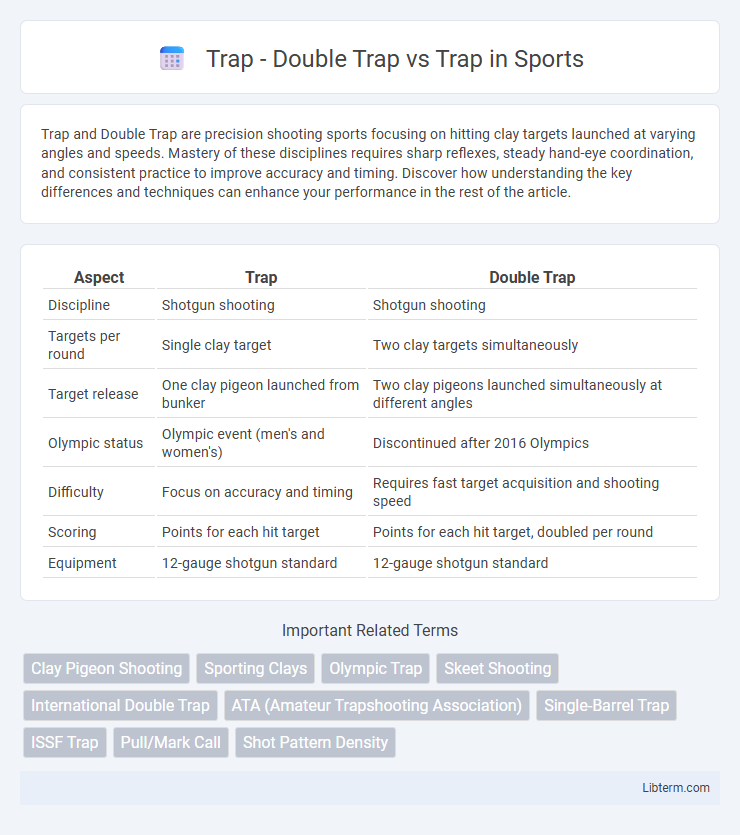Trap and Double Trap are precision shooting sports focusing on hitting clay targets launched at varying angles and speeds. Mastery of these disciplines requires sharp reflexes, steady hand-eye coordination, and consistent practice to improve accuracy and timing. Discover how understanding the key differences and techniques can enhance your performance in the rest of the article.
Table of Comparison
| Aspect | Trap | Double Trap |
|---|---|---|
| Discipline | Shotgun shooting | Shotgun shooting |
| Targets per round | Single clay target | Two clay targets simultaneously |
| Target release | One clay pigeon launched from bunker | Two clay pigeons launched simultaneously at different angles |
| Olympic status | Olympic event (men's and women's) | Discontinued after 2016 Olympics |
| Difficulty | Focus on accuracy and timing | Requires fast target acquisition and shooting speed |
| Scoring | Points for each hit target | Points for each hit target, doubled per round |
| Equipment | 12-gauge shotgun standard | 12-gauge shotgun standard |
Understanding Trap Shooting: An Overview
Trap shooting involves targeting clay pigeons launched from a single machine, emphasizing precision and speed in hitting moving targets. Double trap increases the challenge by releasing two clay targets simultaneously, requiring shooters to quickly prioritize and shoot both targets in rapid succession. Mastery of trap shooting demands refined hand-eye coordination, consistent stance, and timing to excel in both single and double trap disciplines.
What is Double Trap?
Double Trap is a shotgun shooting discipline where two clay targets are launched simultaneously at different angles, requiring rapid target acquisition and precision. It differs from traditional Trap, where only one clay target is released at a time, demanding focused single-target accuracy. The increased difficulty in Double Trap enhances shooter reflexes and timing, making it a more dynamic and challenging variation of the sport.
Key Features of Traditional Trap
Traditional trap shooting involves a single target launched away from the shooter, requiring precision and rapid reaction as the clay pigeon travels along a fixed path. Key features include a stationary trap house that releases the clay pigeons at varying angles within a 22-degree arc, emphasizing consistency in target trajectory and timing. The discipline contrasts with double trap, where two targets are simultaneously released at fixed angles, demanding faster target acquisition and dual-shot accuracy.
Double Trap vs Trap: Target Presentation
Double Trap presents two clay targets simultaneously, released at slightly different angles, demanding rapid tracking and shooting skills. In contrast, Trap features a single target launched at varying angles from a single trap house, focusing on precision and timing for one target at a time. The dual-target challenge in Double Trap requires faster reflexes and more complex target acquisition compared to the singular, varied-angle target of traditional Trap shooting.
Gun and Equipment Differences
Double Trap involves two clay targets released simultaneously, requiring shotguns with faster cycling and specialized choke configurations for rapid target engagement, whereas Trap shooting uses a single clay target allowing for standard single-shot or over/under shotguns optimized for precision. Double Trap guns often feature adjustable stock designs and enhanced recoil pads to manage increased recoil from rapid follow-up shots, while Trap guns prioritize stability and high sighting plane setups for accuracy. Ammunition for Double Trap typically uses lighter loads to facilitate speed and control, contrasting with the heavier payloads favored in Trap for reliable target destruction.
Rules and Scoring: Double Trap vs Trap
Trap shooting involves firing at single clay targets launched from one trap house, while Double Trap requires shooting at two targets released simultaneously from different machines. In Trap, shooters fire at 25 targets per round, scoring one point per hit, whereas Double Trap features 15 pairs per round with a maximum score of 30 points. The key rule difference is that in Double Trap, shooters must engage both targets in quick succession, demanding rapid target acquisition and shot accuracy.
Skill Sets Required for Each Discipline
Trap shooting demands precision, quick reflexes, and effective target tracking as shooters engage single clay targets launched at varying angles. Double trap requires enhanced spatial awareness and faster decision-making due to two clay targets being released simultaneously, challenging shooters to execute rapid consecutive shots with impeccable accuracy. Mastery in double trap also involves superior hand-eye coordination and the ability to anticipate target trajectories under time pressure.
Training Tips for Trap and Double Trap Shooters
Trap shooters benefit from consistent shotgun mount practice and sight picture alignment to improve accuracy, while double trap shooters must emphasize rapid target acquisition and split-second reflex training to handle simultaneous clay target launches. Both disciplines require rigorous mental conditioning to maintain focus under pressure, alongside drills that simulate competition scenarios for improved reaction times. Incorporating dynamic footwork and breath control techniques enhances stability and shot precision in high-stress environments.
Competition Formats and Major Events
Trap shooting features two primary competition formats: Trap and Double Trap, each with distinct rules and target presentations. In Trap, shooters aim at single clay targets released at varying angles from a single machine, whereas Double Trap involves shooting at two targets simultaneously launched from machines set at fixed angles. Major events showcasing these formats include the ISSF World Shooting Championships and the Olympic Games, although Double Trap was removed from the Olympic program after 2016, making Trap the sole shotgun discipline contested at the Games.
Choosing Between Trap and Double Trap
Choosing between Trap and Double Trap shooting depends on the shooter's skill level and reaction time, as Double Trap requires handling two targets launched simultaneously, demanding faster reflexes and better coordination. Trap shooting involves aiming at single clay targets released at varying angles, making it more suitable for beginners or those preferring consistent target patterns. Advanced shooters seeking higher difficulty and faster-paced challenges often prefer Double Trap for its intensity and timing precision.
Trap - Double Trap Infographic

 libterm.com
libterm.com